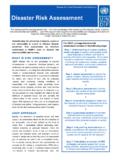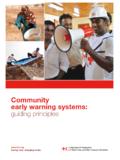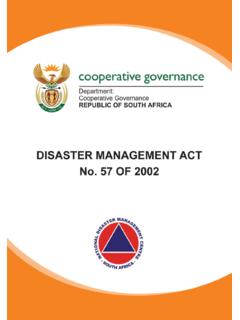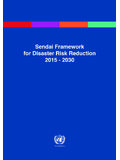Transcription of Social Affairs Insurance against Losses from Natural ...
1 Economic & Social AffairsDESA Working Paper No. 85 ST/ESA/2009/DWP/85 October 2009 Insurance against Losses from Natural Disasters in De-veloping CountriesJoanne Linnerooth-Bayer and Reinhard MechlerAbstractTh is paper examines the recent experience with Insurance and other risk-fi nancing instruments in developing countries in order to gain insights into their eff ectiveness in reducing economic insecuri-ty. Insurance and other risk fi nancing strategies are viewed as eff orts to recover from negative income shocks through risk pooling and transfer. Specifi c examples of public-private Insurance programs for households, business-fi rms, and governments are described, highlighting their limitations, especially in light of the post-Katrina experience in the United States.
2 It examines arguments both in support of and in opposition to donor and public involvement in provision of subsidized Insurance in devel-oping Classifi cation: G11, G14, G22, Q1, Q14 Keywords: Insurance , fi nancing, risk, cost, benefi t, developing country, Natural disaster , climate Linnerooth-Bayer, Leader of the Risk and Vulnerability Program (VAP) of the Interna-tional Institute of Applied Systems Analysis (IIASA), Laxenberg, Austria, e-mail: Mechler, Research Scholar in the Risk and Vulnerability Program (VAP) of the Interna-tional Institute of Applied Systems Analysis (IIASA), Laxenberg, Austria.
3 E-mail: should be addressed by e-mail to the Working Papers are preliminary documents circulated in a limited number of copies and posted on the DESA website at to stimulate discussion and critical comment. Th e views and opinions expressed herein are those of the authors and do not necessarily refl ect those of the United Nations Secretariat. Th e designations and terminology employed may not conform to United Nations practice and do not imply the expression of any opinion whatsoever on the part of the Nations Department of Economic and Social Aff airs2 United Nations Plaza, Room DC2-1428 New York, 10017, USATel: (1-212) 963-4761 Fax: (1-212) 963-4444e-mail.
4 1 disaster risk management .. 3 disaster risk reduction .. 3 disaster risk coping .. 5 Prevention and coping .. 8 Insurance for households and businesses .. 10 Microinsurance schemes .. 10 National Insurance programs .. 12 Insurance for farmers and herders .. 14 Index-based crop Insurance .. 15 Index-based livestock Insurance .. 18 Insurance for governments .. 19 Insuring governments .. 19 Insuring donors that insure governments.
5 21 Pooling small states sovereign 21 Eff ectiveness of current programs .. 22 Benefi ts of Insurance in developing countries .. 23 Costs of Insurance in developing countries .. 23 Risks of Insurance in developing countries .. 24 Th e solvency and sustainability of Insurance systems .. 24 Ineffi ciencies and market distortions arising from outside support .. 25 Moral hazard, adverse selection and basis risk .. 25 Institutional stability, public confi dence and trust .. 26 Climate change.
6 27 Role of donors, NGOs and other international organizations .. 27 Concluding remarks .. 29 References .. 31 Insurance against Losses from Natural Disasters in Developing CountriesJoanne Linnerooth-Bayer and Reinhard MechlerIntroduction Th e impact of Natural hazards - weather variability, climate extremes, and geophysical events - on economic well-being and human suff erings has increased alarmingly. More than three-quarters of recent Losses can be attributed to windstorms, fl oods, droughts and other climate-related hazards (UNISDR, 2007).
7 Th is trend can be attributed largely to changes in land use and increasing concentration of people and capital in vulner-able areas, for example, in coastal regions exposed to windstorms, in fertile river basins exposed to fl oods, and in urban areas exposed to earthquakes (Mileti, 1999). Climate change also appears to be playing a role (Sch nwiese et. al, 2003; IPCC, 2007; Emanuel, 2005). Th e Intergovernmental Panel on Climate Change (IPCC, 2007) has predicted that climate change will increase weather variability as well as the intensity and frequency of climate-related extremes.
8 Low- and middle-income countries, and especially the vulnerable within these countries, suff er the most. During the last quarter century (1980-2004), over 95% of Natural disaster deaths occurred in develop-ing countries and their direct economic Losses averaged US$54 billion per annum (Munich Re, 2005). As illustrated in fi gure 1, a sample of large Natural disasters over this period showed that fatalities per event were higher by orders of magnitude in low- and middle-income countries compared with those in high-income countries; and Losses as a percentage of gross national income (GNI) were also highly negatively correlated with per capita income.
9 Notes: Graphs depicting (i) fatalities per event, and (ii) insured and uninsured Losses according to country income groups. Data source: Munich Re, Note: Country income groups according to World Bank classifi cation using GNI per capita. Low income: less than 760 US$/year, middle income: 760-9360 US$/year, high income: larger than 9360 US$/year in 2005. Figure 1:Diff erential burden of Natural disasters050100150200250 Low incomeMiddle incomeHigh incomePer capita income country groupsFatalities/eventFatalities per income Middle income High incomeUninsured Losses in % GNII nsured Losses as % GNIPer capita income country groupsAsset Losses /GNI2 DESA Working Paper No.
10 85 Developed and developing countries diff er not only in human and economic burden of Natural disasters, but also in Insurance cover. In rich countries about 30% of Losses (totaling about of GNP) in this period were insured; by contrast, in low-income countries only about 1% of Losses (amounting to of GNP) were It should be kept in mind that these Losses generally do not include long-term indirect Losses , which can be very signifi cant, particularly in countries with low capacity to cope. Due to lack of Insurance , combined with exhausted tax bases, high levels of indebtedness and limited donor assistance, many highly exposed developing countries cannot raise suffi cient capital to replace or repair damaged assets and restore livelihoods following major disasters, thus exacerbating the impacts of disaster shocks on poverty and development (Gurenko, 2004).


















